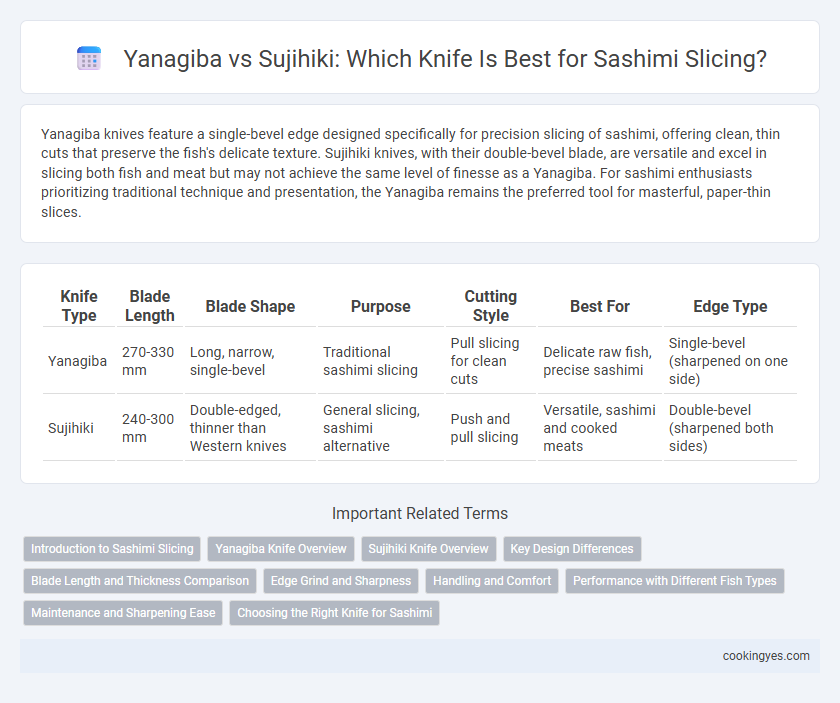Yanagiba knives feature a single-bevel edge designed specifically for precision slicing of sashimi, offering clean, thin cuts that preserve the fish's delicate texture. Sujihiki knives, with their double-bevel blade, are versatile and excel in slicing both fish and meat but may not achieve the same level of finesse as a Yanagiba. For sashimi enthusiasts prioritizing traditional technique and presentation, the Yanagiba remains the preferred tool for masterful, paper-thin slices.
Table of Comparison
| Knife Type | Blade Length | Blade Shape | Purpose | Cutting Style | Best For | Edge Type |
|---|---|---|---|---|---|---|
| Yanagiba | 270-330 mm | Long, narrow, single-bevel | Traditional sashimi slicing | Pull slicing for clean cuts | Delicate raw fish, precise sashimi | Single-bevel (sharpened on one side) |
| Sujihiki | 240-300 mm | Double-edged, thinner than Western knives | General slicing, sashimi alternative | Push and pull slicing | Versatile, sashimi and cooked meats | Double-bevel (sharpened both sides) |
Introduction to Sashimi Slicing
Yanagiba and Sujihiki knives are essential tools for precise sashimi slicing, each designed to enhance the texture and presentation of raw fish. The Yanagiba features a single-edged blade optimized for clean, long, and smooth cuts, reducing cell damage and preserving the delicate flavor of sashimi. Sujihiki knives have a double-edged blade suited for versatile slicing tasks, offering ease of use and efficiency, but Yanagiba remains preferred for traditional, high-quality sashimi preparation.
Yanagiba Knife Overview
Yanagiba knives are traditional Japanese blades specifically designed for slicing sashimi with precision and finesse. Featuring a long, thin, single-beveled edge, the Yanagiba allows for clean, smooth cuts that preserve the fish's texture and presentation. Compared to the Sujihiki, which is more versatile and double-beveled, the Yanagiba excels in delivering expertly sliced sashimi thanks to its sharpness and specialized edge geometry.
Sujihiki Knife Overview
The Sujihiki knife features a long, narrow blade designed for precise, clean cuts ideal for sashimi slicing, allowing for minimal cell damage and preserving fish texture. Unlike the Yanagiba, the Sujihiki often has a double-edged blade, making it versatile for both right- and left-handed users while maintaining sharpness for delicate slicing tasks. Its lightweight design and balanced construction provide enhanced control and smooth slicing action, essential for preparing elegant sashimi presentations.
Key Design Differences
The Yanagiba knife features a single-bevel edge designed specifically for precision slicing of raw fish, allowing for cleaner cuts and preserving the fish's texture and flavor. The Sujihiki, with its double-bevel edge and longer, narrower blade, offers versatility and smooth slicing for both sashimi and other meats. Key design differences include the Yanagiba's sharper, more delicate edge optimized for traditional Japanese sashimi techniques, whereas the Sujihiki provides a more durable, user-friendly blade suited for general slicing tasks.
Blade Length and Thickness Comparison
Yanagiba knives typically feature longer blades, ranging from 9 to 12 inches, with thinner edges specifically designed for precise, single-stroke cuts essential in sashimi preparation. Sujihiki knives have slightly shorter blades, usually between 8 to 10 inches, and possess a thicker profile, offering more versatility but less finesse in delicate slicing. The thinner blade of the Yanagiba reduces drag during slicing, preserving the texture and integrity of raw fish, while the Sujihiki's thickness provides durability for general slicing tasks.
Edge Grind and Sharpness
Yanagiba knives feature a single-bevel edge grind, creating an exceptionally sharp blade optimized for precise sashimi slicing, allowing clean cuts that preserve the fish's texture and presentation. Sujihiki knives use a double-bevel edge grind, offering versatility but slightly less sharpness compared to Yanagiba, making them suitable for general slicing yet less specialized in delicate sashimi preparation. The sharper, more refined edge of the Yanagiba excels in producing thin, uniform sashimi slices, critical for authentic Japanese culinary techniques.
Handling and Comfort
Yanagiba knives offer superior handling with their lightweight, single-beveled blades designed specifically for precise sashimi slicing, providing excellent control and clean cuts. Sujihiki knives, while also effective, are generally double-beveled and heavier, which can impact comfort during extended use but offer versatility beyond sashimi preparation. The thinner, sharper edge of the Yanagiba enhances slicing accuracy and reduces resistance, making it a preferred choice for expert chefs focused on delicate fish preparation.
Performance with Different Fish Types
Yanagiba knives excel in precision when slicing firmer fish like tuna and bonito, providing clean, delicate cuts that preserve the fish's texture and flavor. Sujihiki knives perform better with softer fish such as flounder and salmon, offering smoother slicing through tender flesh without tearing. The choice between Yanagiba and Sujihiki significantly impacts sashimi quality depending on the fish type used.
Maintenance and Sharpening Ease
Yanagiba knives, traditionally used for sashimi, require meticulous maintenance due to their single-bevel edge that demands precise sharpening with whetstones, often necessitating professional skills. Sujihiki knives, featuring a double-bevel edge, offer easier sharpening and maintenance, making them more user-friendly for home cooks while still delivering clean sashimi slices. Regular honing and correct sharpening angles are critical for both knives to preserve the blade's sharpness and slicing performance.
Choosing the Right Knife for Sashimi
Selecting the right knife for sashimi slicing involves choosing between the Yanagiba and Sujihiki, each designed for precision and clean cuts. The Yanagiba, a traditional Japanese single-bevel knife, excels in creating smooth, delicate slices essential for high-quality sashimi, while the Sujihiki, a double-bevel Western-style knife, offers versatility and ease of use for both beginners and professionals. Understanding the differences in blade design and cutting technique is crucial for achieving optimal texture and presentation in sashimi preparation.
Yanagiba vs Sujihiki for sashimi slicing Infographic

 cookingyes.com
cookingyes.com